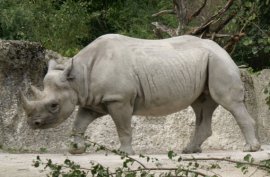|
|
|

The White Rhino could once be found across sub-Saharan Africa but today its numbers are down to around 11,000, mostly in South Africa and they have virtually been wiped out in more northern areas. The White Rhino prefers flat grasslands whereas the Black Rhino prefers woodlands. Both enjoy waterholes and are most active at night. The African Rhino is a herbivore. Both rhinoceros's (from the Greek words – rhino (nose) and ceros (horn)) are at serious risk from poaching, with their horns seen, particularly in the east, as having medicinal qualities (although there is no scientific evidence of their medicinal value) as well as ornamental value and this risk has been exacerbated with the levels of civil unrest across large swathes of the African continent since the 1960s.
They live in "crashes" with a gestation period of 15 months. If broken off these horns re-grow. The young will stay with their mother until another calf is born by which time they are usually fully grown and ready to live by themselves. The female buffalo normally has offspring every two years from the age of 4-5yrs with a gestation period of 11-12 months and the children, once born, remain dependent on their mother for almost a full year. Female calves tend to remain in the herd permanently, whilst the males often leave by the age of four. |



 Today the Black African rhino can be found in Angola, Kenya, Mozambique, Namibia,
South Africa, Tanzania and Zimbabwe as well as Botswana, Malawi, Swaziland and Zambia where it has been successfully reintroduced.
Today the Black African rhino can be found in Angola, Kenya, Mozambique, Namibia,
South Africa, Tanzania and Zimbabwe as well as Botswana, Malawi, Swaziland and Zambia where it has been successfully reintroduced. They are attacking beasts (charge first, ask questions later) with a horn made not of bone but from the same material as makes up human hair and nails, keratin, with the horns growing continuously throughout their lifetime, with the white rhino’s horn capable of growing 7cm every year, and the record length for a horn is 150cm long.
They are attacking beasts (charge first, ask questions later) with a horn made not of bone but from the same material as makes up human hair and nails, keratin, with the horns growing continuously throughout their lifetime, with the white rhino’s horn capable of growing 7cm every year, and the record length for a horn is 150cm long.


